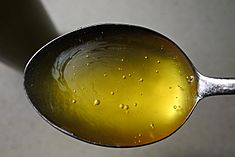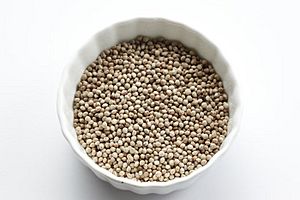Perilla oil facts for kids
Perilla oil (들기름 Deulgireum) is a special oil that comes from the seeds of the perilla plant. It has a unique nutty smell and taste. When the seeds are toasted, the oil is used in Korean cuisine to add flavor, as a sauce, or for cooking. Oil made from seeds that haven't been toasted is used for other things, not for eating.
 |
|
| Nutritional value per 100 g (3.5 oz) | |
|---|---|
| Energy | 884 kcal (3,700 kJ) |
|
100 g
|
|
| Saturated | 6-10 g |
| Monounsaturated | 12-22 g |
| Polyunsaturated
omega‑6
|
65-86 g
52-64 g
14 g
|
| †Percentages estimated using US recommendations for adults. | |
Contents
How Perilla Oil is Made
Perilla oil is made by pressing the seeds of the perilla plant. These seeds are quite oily, with about 38% to 45% of their weight being oil. It's a bit like how olive oil is made from olives!
What's Inside Perilla Oil?
Perilla oil is full of important fats called fatty acids. These include both saturated and unsaturated fats.
Types of Fats in Perilla Oil
- Saturated fats: The main ones are palmitic acid (5-7%) and stearic acid (1-3%).
- Monounsaturated fats: Oleic acid makes up 12-22% of these fats.
- Polyunsaturated fats: These include linoleic acid (13-20%), gamma-linolenic acid (0-1%), and alpha-linolenic acid (54-64%).
Omega-3 and Omega-6 Fats
Perilla oil is special because it has one of the highest amounts of omega-3 fatty acids compared to other plant oils. About 54% to 64% of its fat content is omega-3. It also contains about 14% omega-6 fatty acids. These fats are important for your body!
How Perilla Oil is Used
Perilla oil is used in many ways, both in the kitchen and for other purposes.
Perilla Oil in Cooking
In Korean cuisine, perilla oil and sesame oil are very popular for adding flavor to dishes, making sauces, and creating dips. The oil made from toasted perilla seeds is used to boost flavors, as a condiment, and for cooking.
You can use perilla or sesame oil for:
- Flavoring namul (vegetable side dishes).
- Pan-frying jeon (delicious pan-fried dishes).
- Coating gim (seaweed sheets) before roasting them.
- Making the base for dipping sauces.
Perilla oil is especially common in the southern parts of Korea because the perilla plant grows well in warmer areas. Today, chefs even use perilla oil in Korean-style Western food. For example, a famous restaurant in Seoul uses perilla oil as a "secret ingredient" in its nutty vanilla ice cream!
Perilla Oil for Other Uses
Oil made from untoasted perilla seeds is used for things other than food. It's a "drying oil," which means it hardens when exposed to air. This makes it useful in many products.
Historically, perilla oil has been used for:
- Paints and varnishes: It helps these products dry and form a hard, protective layer.
- Printing ink: It's a key ingredient in making inks for printing.
- Linoleum: This type of floor covering also uses perilla oil.
- Waterproof coatings: It was used to make cloth waterproof.
- Fuel: In ancient Japan and Korea, perilla oil was used to fuel oil lamps. In Japan, it was a main lamp fuel until the early 16th century.
It dries faster than linseed oil and creates a harder film, though it might yellow a bit more. The paint and varnish industries are the biggest users of perilla oil for these purposes.
What's Left After Pressing?
After the oil is pressed out of the perilla seeds, the leftover material is called "press cake." This press cake can be used in helpful ways too! It can become a natural fertilizer for plants or even animal feed.
See also
 In Spanish: Aceite de perilla para niños
In Spanish: Aceite de perilla para niños



